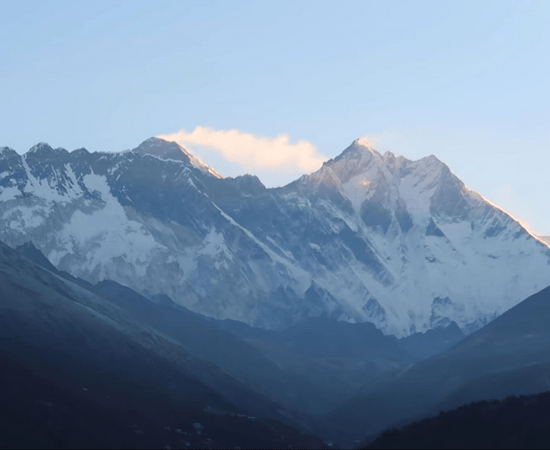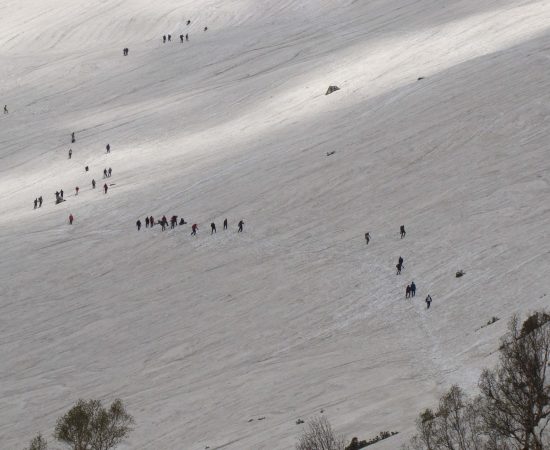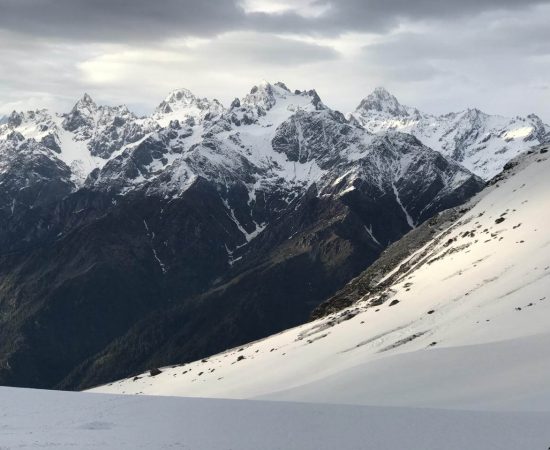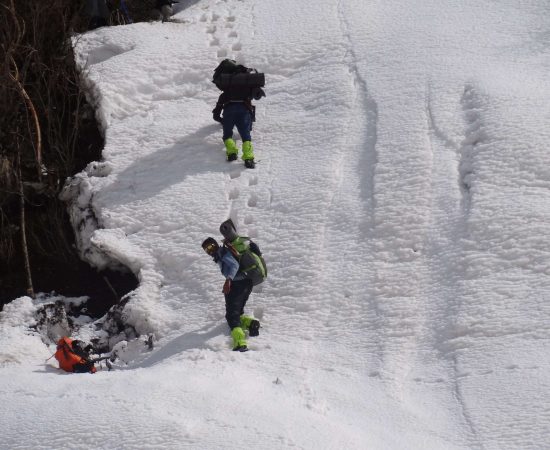Kheer Ganga Trek
Manikaran, Himachal Pradesh
Rated 4.9/5.0 on TripAdvisor. 550 Reviews


Key Highlights
- Altitude : 2960 m/9700 ft
- Time : 2 Days - 1 Nights
- Region: Parvati Valley, Manikaran
- Best Time: April-December
- Distance: 22Kms
- Grade: Easy
Overview
Kheer Ganga Trek
Hot springs and lovely views of the Himalayan highlands may be found on the Kheer Ganga Trek. It is situated in the Kullu area of Himachal Pradesh. Around 22 kilometres from the Manikaran pilgrimage site, soothing activities include hiking through the dense forest and taking a dip in the hot springs. You may go hiking, camp in the bush, and snap pictures of nature while you're at the Kheer Ganga walk. Both watching the sun set and hiking among the Kheer Ganga trees are wonderful experiences. The last noteworthy aspect is Barshaini. To go to Kheerganga, it is recommended to hire a guide. It takes 4 hours to walk from Barshaini to Kheer Ganga.
You will travel through the community and many tourist attractions, including the waterfall with a serpentine form called Rudra-Nag, while walking from Barshaini. After Rudra Nag has walked over the bridge over the Parvati River, the terrain becomes steep. There are both steep and flat sections of the trail. When we reach the Kheer Ganga hillside, we can see the temple and food tents. The hot spring in this temple, which is dedicated to Lord Shiva and Goddess Parvati, has therapeutic properties. This hot spring is a good place to unwind after a strenuous trek. Between May and November, when the weather is moderate and pleasant, is the best time to visit Kheer Ganga.
The trek is avoided in the winter because the snow makes the rocks slippery and the route difficult to navigate. Near Kheer Ganga, there are a few eateries along the road that provide vegetarian and non-vegetarian Indian, Chinese, and continental food. The Shiva temple is next to an ashram that offers simple housing and other amenities. Kartikeya, the younger son of Lord Shiva, is said to have meditated for a thousand years at Kheerganga, making it a particularly significant Hindu pilgrimage site.
Cost Per Person
Key Highlights
- Altitude : 2960 m/9700 ft
- Time : 2 Days - 1 Nights
- Region: Parvati Valley, Manikaran
- Best Time: April-December
- Distance: 22Kms
- Grade: Easy
Complete
Itinerary of trek
We will assemble at Barshaini around 9:30 am to begin our trek for Kheerganga. For the initial part of the trek we will have to climb down from the road head to the river and cross it via using a wooden bridge installed specially for trekkers on this route. After crossing the bridge the real climb towards Kheerganga starts. The beginning of the climb is steep with a zig zag trail along wooden houses and coniferous trees.After a while you will start getting a view of Nagthan village. So make a little more effort on the steep climb and you will reach Nagthan village. Here, you can treat yourself to some hot tea and maggie or eggs to give you more energy for the journey ahead. This is the last place where you can stock up for supplies which you might need ahead. After Nagthan, the trail is a gradual ascent through grass lands and apple orchards while the Pir Panjal range oversees your journey through the valley. After trekking for almost an hour you will reach the holy spot of Rudranag, where it is said Lord Shiva meditated on this spot thousands of years ago. The most distinct feature by which you can spot the snake-like shape. As we move ahead in our journey to Kheerganga we will cross the gushing Parvati river which you can view from close by now. After crossing the river the trail will get steep and we enter into the coniferous forest. The trees in this forest are mostly deodar and you can easily make out that some of them are even hundred years and above. The steep trail through the forest takes about 2 hours to complete. As you reach near Kheerganga, you start seeing signs which tell you that you are almost there. This last little bit is the trickiest as the ascent is steep and you have reached an altitude where you can feel the air getting thinner as the forest opens up into a huge grassland stretch across the mountain. After reaching Kheerganga you will be greeted with a hot meal and tea. In the evening you have time for leisure so you can walk around the meadow and let the immense beauty of the valley sink into you. Overnight stay in tents at Kheerganga campsite.
We wake up in the morning and enjoy a cup of tea out in the open with the majestic mountains overlooking you from above. After having breakfast we will take a tour of Kheerganga which is the pilgrimage spot for the locals and there are many mythological stories attached to this place. We will cross all the cafes and tents to reach the Kheerganga Hot Spring. Earlier it was a pool open for everyone to bathe but as tourists started flocking to the area a lot of religious sentiments were hurt so they turned the pool into a bathing area where people can come and bathe in the naturally hot water of the Sulphur springs. The water is hot due to geothermal energy and is rich in Sulphur which is said to be good for the skin and cures a few illnesses as well. Right above the hot spring there is an Ashram where you can get simple accommodation and food at cheap prices. From there you can find a Cave named Gupt Kartik Gufa dedicated to Lord Kartik who is the son of Lord Shiva and also the god of Beauty and War. He is said to have meditated in the cave for a thousand years. The mountains above Kheerganga are home to Bunibuni glacier. We will return to our campsite after our tour of Kheerganga and prepare to depart for Barshaini. We will say goodbye to all the staff who made the trek possible and depart for our 11km trek back to Barshaini.
Enquiry For Group Bookings
Guidelines
➽ Preparation for Trek
As you well know, the great Himalayan trek is one that requires careful preparation, a strategy that allows for enough flexibility to adapt to whatever challenges may arise.
Therefore, here are some things to consider before setting out on your trek:
⦿ Physically – You should start working out at least a month before signing up for a program if you want to be physically prepared for the rigours of a journey. Strengthen your legs by jogging and working out regularly to increase your stamina. To better acclimatise to the environment and increase your resilience on the walk, you should give up smoking and undertake breathing exercises twice a day. Engage in vigorous physical activity, such as playing sports, doing Yoga, or running.
⦿ Mentally –
Getting in shape physically is essential, but mental preparation is just as crucial for a successful walk. Take time to enjoy your regular activities, maintain a healthy diet and sleep schedule, and unwind before embarking on a hike. Predictions regarding the journey should not cause mental worry. Spend time with your closest pals to recharge your batteries and renew your spirit. Pre-trek preconceptions are unwarranted since the first contact with the other trekkers is certain to be a source of inspiration and energy. Conditions during the walk will contribute to the increase in mental readiness. The mental repercussions of physical disadvantages will not be ignored. So, when you hike, pay attention to different regions of your body and purposefully relax them. If you want to enjoy your hike, you should learn to loosen up a little, particularly in the hips. Think about your descent as a simple dance, and enjoy the natural rhythms that the path and your body can discover together gradually, whether you're on a flowing downhill route or a frightening slope. Try out a few new walking techniques to add some fun to your commute without worrying about getting somewhere in particular. Maintaining mental fitness mostly requires a willingness to relax and take in the journey, rather than subjecting oneself to undue stress.
⦿ Technically-
Get the right size hiking boots and go for it, from a technical standpoint. You should make use of 60 litres. To become acclimated to carrying heavy items, it is recommended to utilise a backpack on a regular basis. Get a hiking stick, a water bottle, some thermal socks, a fleece or feather coat, some long pants, a poncho, some flip-flops, and any devices you may need like a camera or a power bank (DSLR or digital camera).
Guidelines
➽ Things to Carry
- Good Trekking Boots: You need sturdy trekking boots with supportive high ankles. Don't bring your running shoes. U can carry extra floaters/flip flops also.
- Wear warm clothing, such three-layer coats, fleece upper, hollow fill or down-filled jackets. Carry full-sleeved T-shirt. Carry cotton hiking trek pants and warm pant for your lower body. Never bring shorts or jeans on a hike.
- Take top and bottom thermals with you.
- Quick dry towel with light weight and Personal toiletries. Suns cream lotion, sanitizer, tooth brush ad toothpaste, lip balm and antibacterial powder.
- Socks: Bring two pairs of regular socks and two pair of wool socks for wearing at night.
- A head torch is required.
- Sunglasses/ Goggle: UV-protected sunglasses are necessary to protect against sunlight and Snow Mountain.
- There should also be a woolen cap / balaclava, cap, neck gaiter cum face mask and warm fleece and waterproof summit gloves since it will be chilly. Keep waterproof gloves on hand since they become wet in the snow.
- Everyone taking part in the activity should have their own lunchbox, spoon, mug and water bottle/ hydration pack of 2 ltr.
- Raincoats/ponchos: Since snowfall and rain are frequent at high elevations, it is important to have one on hand so as to avoid getting wet.
- Trekking bag of 75 ltr with rain cover.
- Walking stik.
- Electronics: camera (optional) USB cable/USB solar charger, charger/earphones, Power bank fully charged.
- Personal first aid box. Emergency ration, energy bars, dry fruit, electoral/Ors
- Required Documents:
a) Registration Form
b) Medical Certificate (signed by a licensed MBBS physician)
c) NOC form (completed by the trekker)
d) 2 passport-size photos
e) ID Proof photo (not PAN)
g) Insurance upto 5 lac..
Guidelines
➽ How to Reach
How to reach Manali:
Delhi and Manali are linked nicely. You may travel from Delhi to Manali in 12 to 14 hours via overnight bus (approx 540 KMS). Online ticket reservations are available at www.redbus.in and www.hrtc.gov.in Tip: Given the distance between Delhi and Manali, the majority of Volvo private buses depart Delhi between 5 and 8 p.m. At 8.30 p.m., the final government bus departs from ISBT Kashmere Gate. Between Rs. 1,200 and Rs. 1,800 are charged by Volvo buses each sector from Delhi to Manali and vice versa. Delhi to Manali: Buses depart from Manali for Delhi between 4 and 8 p.m., same like the return trip. You should expect to arrive in Delhi any time between six and ten in the morning. Plan your subsequent trips just after midday, leaving ample time for bus delays.
How to reach Kasol:
Bhunter and Kasol are separated by 25 kilometres, and several buses operate every 15 minutes. On the left bank highway, 25 kilometres from Kasol, there is an additional exit at Bhunter. Between Kullu and Manali is where you may find Hunter. From Manali or Bhunter, you may take a cab or a local bus to Kasol.
How to reach Naggar:
Naggar is 18 kilometres from Manali, and there are several buses that operate every 15 minutes. Alternatively, one may get out at Patlikuhal, which is 5 kilometres from Naggar on the right bank highway. Between Kullu and Manali is Patlikuhal. To get to Naggar, you may take a cab or a local bus from Manali or Patlikuhal.
The closest train station is:
Ambala (350 miles) and Chandigarh are the closest railway stations (310 kms). Advice: From Chandigarh to Manali, regular buses and Volvos run in the evening. Volvo buses from Chandigarh to Manali and vice versa charge between Rs. 800 and Rs. 1,200 every sector.
The closest airport:
The closest airport to Manali is Bhuntar, which is 52 kilometres distant. From Bhuntar to Manali, taxi services are available and cost between Rs. 1500 and Rs. 2,500. Air travel between Bhuntar and Delhi is convenient. Airlines providing flights from Delhi and Chandigarh to Kullu include Indian Airlines, Kingfisher Airlines, MDLR Airlines, and Jagson Airlines.
➽ Trip Cost Includes
- Conveyance within the journey.
- Tents that can be shared.
- Advanced and knowledgeable himalayan adventure trips guide.
- Cooks, helpers, and other necessary personnel.
- Vegetarian meals (breakfast, lunch, and dinner) along the journey
- Every organisational prerequisite for a journey
- First aid kit with portal oxygen.
- Camping fees and forest permits.
- All permissions for hiking.
- All meals will be supplied while on the hike. Freshly cooked meals will include a mix of indian, chinese, and continental cuisines.
- Lodging at a hotel, guest house, home, or in tents.
- All of the group's trekking equipment (tents at base camp, use of base camp facilities)
- All trip workers, including porters and mules for everyday items (such as food, tents, and utensils)
➽ Trip cost Excludes
- Airfare or other forms of transportation costs.
- Meals and hotel accommodations.
- Personal costs include washing, cell charging, and lodge showers
- Entry permits or permission for the inner line for foreign participants.
- Personal apparel and hiking supplies, such as liners for sleeping bags and walking sticks, are required.
- Any expenditures associated with rescue efforts or an early expedition departure.
- Guides and sherpa crew are tipped.
- Personal porters to carry hikers' packs
- Personal liability insurance or emergency evacuation costs
- Personal purchases (such as bottles of mineral water, bottled or canned drinks, chocolate, dried fruit, presents, etc.).
- From and to the trailhead, food.
- 5% goods and service tax (gst).
Guidelines
➽ Special Casual Leaves
Government employee can avail the benefit of special casual leave when u join us for a trekking expedition. As per the rule of the pay commission, special casual leave can be availed for up to 30 days in a calendar years for trekking and mountaineering expeditions through a register organization. Himalayan adventure trips are a register adventure tour operator register with Indian mountaineering foundation and Himachal Pradesh tourism. Candidates have to apply for leave at least 30 days before the trek/expedition start.
Testimonials
➽ Provided By The Customers
Everything about our visit to Prashar lake was better than we could have imagined. From our initial contact with Himalayan Adventure Trips, we felt their genuine interest in learning about our group's goals and expectations, and our travels with them reinforced at every turn that they not only understood our requirements but also have the acute skill and expertise to achieve them. Having already had such a wonderful experience with this firm, I will be promoting a trek to Prashar lake to all my friends who share my passion for hiking and will specifically recommend that they work with this outfit. Absolutely fantastic; I have nothing but praise for it.
How useful was this post?
Click on a star to rate it!
Average rating 0 / 5. Vote count: 0
No votes so far! Be the first to rate this post.







